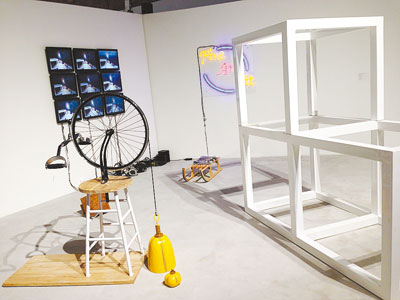 Anna Zhao anna.whizh@yahoo.com AN exhibition showcasing works of young artists from China’s top art academies is being staged at the Shenzhen OCT Contemporary Art Terminal (OCAT) at OCT-LOFT in Nanshan District through Oct. 25. Themed “Fresh Vision — Spy … Magnify,” the exhibition presents a comprehensive view of the development of art among art students who are at the crossroads of their lives before graduation. While the exhibition is a selection of 40 diverse works, installation art is the most prevalent form, in addition to sculpture, experimental art, video images, paintings and designs. A prominent characteristic of the exhibits is that many of the works carry strong imprints of the Internet information age such as the remix of signs, the assemblage of images and other mediums, the employment of cross-disciplinary knowledge or multimedia experiments. “Light” by Liao Binbin from the Tianjin Academy of Fine Arts uses an installation to simulate a light beam’s path by combining seemingly irrelevant objects. In the work, time and light are connected with light beams from a flashlight penetrating through an old TV and a fish bowl before finally reaching a clock. By parodying airwaves and light waves, Liao turns the invisible into visible lines. For example, an air conditioner is used as a light source to vent light waves and a fire extinguisher sprays out light onto a sculpture. “Designer” by Liu Hange from the Central Academy of Fine Arts is a group of digital designs depicting cultural elements or aspects of life. The artist uses signs that are highly recognizable from daily life but redesigned them to create new meaning, sometimes humorously. “Old Things in the City” by Wang Xiaoman from the Central Academy of Fine Arts is an installation that demonstrates modern life brightened by recycled materials. Old wooden furniture is refitted as an aquarium stand. A tapestry is made by piecing together small patches of old bed sheets with a traditional floral pattern. Even worn-out cowboy jeans are transformed into a tapestry of amusing patterns. The artist said he was inspired to use the material when his parents’ house in the countryside underwent a process of “urbanization” — many old utensils were abandoned to make room for new house — but Wang felt nostalgia for those old things that were reminiscent of his childhood. Multi-disciplinary collaboration is indispensable from installation art, as many artists, like physicians doing experiments, employ mechanical objects to fulfill their creations. “Convertor Belt for Illusion” by Zhou Shengyu from the Xi’an Academy of Fine Arts is an installation with a thin sheet of film rolling on a mechanical transmission device to create film-like visual effects. When a sheet of half-transparent film moves along a still film sheet beneath, new dynamic pictures are created out of the interlaced patterns on the two layers of films. “Fine Art Fit” by Cui Yanbin from the Central Academy of Fine Arts is an installation that simulates fitness club machines. In “1029 Node” by Lin Jiahua from the Guangzhou Academy of Fine Arts, mechanic parts are used to replace animals’ internal organs to fulfill biological functions. In the Internet information age, the observation of and reflection on humans and the human body continue to be an everlasting concern for artists, as people are facing a more complex environment bombarded with readily available but fragmented knowledge from the powerful mobile Internet. But the focus of the artists’ attention seems to be shifting from people’s social roles to the human body’s changes, its inner structure and its connections with the external world. Wood sculpture “Gestation” by Lu Qian from the China Academy of Art is an exploration of life’s possibilities. The sculpture consists of seven tree trunks with big, bulging lumps — like a pregnant woman’s belly — to symbolize new life in the conception stage. In “The Seafood Restaurant” by Li Bolin from the China Academy of Art, the artist tells a story with various characters painted in a cartoonish style — all the characters are eerie alien creatures. The artist said he deliberately depicted the characters as abnormal because he thinks the real world is full of mystery. The exhibition’s curators said the works were chosen based on multiple criteria, not just the traditional, monolithic standards of skill. Curator Liu Qingyuan said the boundary between art and non-art is becoming blurred at a time he called “the age of knowledge assembly.” In his opinion, all contemporary art is akin to a method of arrangement — the self-assembly of a thing or person, and the young artists’ experimental projects is an influence of developments in Internet technology and applications in life and society. Curator Hu Bin said he hopes the exhibition will become a platform that will allow student works to be judged by the public and encourage young artists to think of fine-tuning their ideas with a social aspect. “In the Internet information era, it’s hard to judge future trends in art. All we can do is to observe and display what artists have created in the present, but what’s popular during our time is not necessarily good art,” Hu said. Hu said only about 10 percent of art students have a career in art for four or five years after graduation, largely because many students cannot find their way into the market. “It is a big question young artists have to think about: how can they adapt themselves to the social environment and continue their art life after they leave school and no longer have the financial support of their parents?” he said. | 
